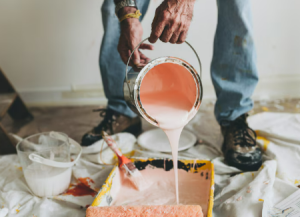Does My Palm Harbor Home Need Primer Before Painting?





 If you’re planning to repaint your home, there’s one crucial step that often gets overlooked—primer. While it might seem like an optional add-on, using the right primer can mean the difference between a vibrant, long-lasting paint job and one that peels, fades, or bubbles within a year. For homeowners in Florida, especially in humid coastal towns like Palm Harbor, primer isn’t just helpful—it’s essential. A professional Painter in Palm Harbor will always evaluate whether primer is necessary and select the right type based on your home’s material, age, and condition.
If you’re planning to repaint your home, there’s one crucial step that often gets overlooked—primer. While it might seem like an optional add-on, using the right primer can mean the difference between a vibrant, long-lasting paint job and one that peels, fades, or bubbles within a year. For homeowners in Florida, especially in humid coastal towns like Palm Harbor, primer isn’t just helpful—it’s essential. A professional Painter in Palm Harbor will always evaluate whether primer is necessary and select the right type based on your home’s material, age, and condition.
In this in-depth guide, we’ll answer your most pressing questions about primer, including:
- What primer does and why it’s important
- How Florida’s climate affects paint performance
- When and where you absolutely need to use primer
- How to select the right primer for your project
- What happens if you skip priming altogether
- Tips for maximizing durability in Palm Harbor’s harsh conditions
Let’s dive in.
What Is Primer and What Does It Do?
Primer is a preparatory base coat applied before painting. It performs several critical functions:
- Seals the surface, especially porous materials like new wood, drywall, or stucco.
- Improves adhesion, allowing paint to bind more effectively and evenly.
- Blocks stains and discoloration, such as water marks, rust, or smoke damage.
- Creates a uniform color base, especially when changing paint shades.
- Extends the life of the paint, reducing the likelihood of peeling or bubbling.
Without primer, your paint is directly exposed to all the imperfections, texture variations, and contaminants in the surface beneath it—compromising both appearance and longevity.
Florida’s Climate: Why It Demands Primer
Palm Harbor’s subtropical climate introduces unique challenges for paint, including:
☀️ UV Radiation
The sun in Florida is intense and constant. UV rays degrade pigments and resins, causing paint to chalk, fade, or crack. Primer with UV-resistant properties can buffer that impact, preserving your color longer.
🌧️ Heavy Rainfall and High Humidity
Moisture is a serious threat to unprimed surfaces. Wood, stucco, concrete, and drywall all absorb moisture easily—especially in a climate where afternoon rain is a near-daily event. Primer seals these materials, preventing mold, mildew, and bubbling.
🌬️ Salt Air (for Coastal Properties)
If your home is near the Gulf of Mexico, you’re constantly battling salt corrosion. Salt particles break down paint and accelerate deterioration. Specialized primers create a barrier that helps prevent salt damage on metal, wood, and siding.
🌡️ Heat Expansion and Contraction
Temperature fluctuations cause siding and stucco to expand and contract, which stresses your paint. Quality primers add flexibility to the paint system, reducing cracking and splitting.
When Primer Is Absolutely Required
There are several situations when primer is a non-negotiable part of the painting process.
1. Painting Over New or Bare Surfaces
Raw wood, concrete, stucco, and drywall all require primer. These materials are porous and absorb paint unevenly, resulting in blotchy coverage without a primer layer to seal the surface.
2. Changing Paint Colors
If you’re transitioning from a dark to a light color (or vice versa), primer helps block the original shade and provides a neutral base for better color accuracy.
3. Covering Stains or Damage
Water stains, rust spots, smoke discoloration, or patched areas all need primer to prevent “bleed-through.” Specialized stain-blocking primers are designed for this purpose.
4. Painting High-Humidity Rooms
Bathrooms, laundry rooms, and kitchens benefit from mold- and mildew-resistant primers, which help defend against Florida’s moisture-heavy indoor environments.
5. Switching Paint Types
If your walls were previously coated with oil-based paint and you’re now using latex, you’ll need a bonding primer to ensure compatibility and adhesion.
6. Metal Surfaces
Garage doors, railings, window frames, and other metal fixtures exposed to the elements need rust-inhibitive primers for proper protection.
Choosing the Right Primer for Palm Harbor Homes
Not all primers are created equal. You need to choose based on both the material being painted and Florida’s environmental factors.
Recommended Primer Types:
|
Surface or Situation |
Recommended Primer Type |
|
New drywall or interior walls |
Latex-based drywall primer |
|
Bare or stained wood |
Oil-based or shellac stain-blocking primer |
|
Concrete or stucco |
Masonry or elastomeric primer |
|
Metal surfaces |
Rust-inhibitive, oil-based primer |
|
Previously painted glossy surfaces |
Bonding primer |
|
Mold/mildew-prone areas |
Mold-resistant latex primer |
|
Exterior walls exposed to salt air |
Acrylic primer with anti-corrosive additives |
An experienced Painter will always tailor primer selection to your home’s surfaces and its exposure to Palm Harbor’s weather.
What Happens If You Skip Primer?
It may seem like a time- and money-saver, but skipping primer can cost you big in the long run. Here’s what you risk:
- Peeling or flaking paint within months
- Uneven sheen or blotchy color
- Premature fading
- Water damage or mildew under the paint
- Increased repainting costs in 2–3 years instead of 8–10
Skipping primer in a climate like Palm Harbor’s is asking for trouble.
Can Paint-and-Primer-in-One Products Replace Primer?
Paint-and-primer combos can work if you’re repainting a clean, previously painted surface in a similar color. But they aren’t a true substitute for dedicated primers when:
- Painting new or uncoated surfaces
- Covering dark colors or stains
- Dealing with moisture-prone areas
- Painting high-alkaline materials like concrete or stucco
In Florida, most pro painters still use separate primers for full surface protection.
Tips for Maximizing Primer Effectiveness
- Always clean the surface thoroughly before priming.
- Allow sufficient drying time, especially in humid weather.
- Use high-build primers to smooth textured surfaces like stucco.
- Tint your primer toward your final paint color to reduce topcoats.
- Apply with the correct tools—sprayer, roller, or brush based on surface type.
- Use multiple coats on high-exposure walls or severe stains.
Professional vs. DIY Priming
Applying primer might seem easy, but getting it right takes expertise. A skilled Painter in Palm Harbor will:
- Know which primers work with which surfaces
- Prep the area correctly to ensure adhesion
- Apply evenly without roller marks or missed spots
- Use commercial-grade products that outperform retail options
- Identify hidden issues (like mold or substrate damage) before priming
A Solid Foundation Is Everything
In Palm Harbor’s weather-intensive environment, painting without primer is like building a house without a foundation. The finish may look fine for a while—but moisture, heat, and UV rays will eventually expose the shortcuts. Primer isn’t just an optional step; it’s your first layer of defense against Florida’s toughest elements.
If you’re ready to paint your home and want the best results possible, make sure priming is part of the plan—and work with a trusted Painter who takes the time to do the job right, from base coat to topcoat.
Now that you understand how to prepare your surfaces properly, revisit our first post—What Type of Paint Is Best for Florida’s Humid Climate?—to choose the perfect product for durability, beauty, and weather resistance in your next paint project.

100% Satisfaction Guarantee

Licensed and Insured

Color Consultation

3 Year Warranty
Services

Our team of experts does popcorn ceiling removal and wallpaper removal. We also do drywall and stucco repairs as well as texturing, soffit and fascia repair.
Painting Service Locations

How long does it take to paint my house?
What is included with your free estimate?
All of our estimates include a fully detailed scope of the work to be completed. You will receive a report with a breakdown of the cost and time estimated for your project.
How do I get my project scheduled?
Simply follow the steps in the estimate to schedule or give us a call, text, or email. Whichever is convenient for you works for us.
Why does a house have to be pressure washed before painting?
If you’re planning to paint the exterior of your home, you may be wondering why pressure washing is such an important step. After all, a little dirt and grime shouldn’t stop the paint from sticking, right? Unfortunately, it’s not that simple. Over time, dirt, mildew, and other pollutants can build up on the surface of your home, causing the paint to chip and peel. Pressure washing removes this build-up, giving the new paint a clean surface to adhere to. In addition, pressure washing also helps to remove any chalky residue left behind by old paint. This ensures that the new paint will have a smooth, even finish. For these reasons, it’s always best to have your home professionally pressure washed before painting
Item How often does a house need to be repainted?
The frequency with which a house exterior needs to be repainted depends on a number of factors, including the type of paint used, the climate, and the level of exposure to sun and rain. In general, however, most experts recommend repainting every three to five years. High-quality paints that are properly applied can last for about 10 years, while lower-quality paints may last less. The climate also plays a role in how often a house needs to be repainted. For example, homes in areas with high humidity levels may need to be repainted more frequently than homes in dry climates. Exposure to sun and rain can also shorten the lifespan of paint, so homes that are exposed to these elements may need to be repainted more often than those that are not. Ultimately, the best way to determine how often a house exterior needs to be repainted is to consult with a painting contractor who can assess the condition of the paint and make a recommendation based on individual circumstances.
Trustindex verifies that the original source of the review is Google. I want to thank Curb Appeal Pros for doing an amazing job of painting the exterior of my house. Sending a big shout out to owner, Jay McGarrity, for being so patient, professional, and fair with the pricing, timing, and color choices. When I changed my mind about the original colors that I had selected, Jay came back to my house twice (including Father's Day) to test some different paint samples I had purchased from Sherwin Williams. The final result was exactly what I wanted and my house looks fabulous! I will hire Curb Appeal Pros again when I am ready to have some interior painting done.Trustindex verifies that the original source of the review is Google. They repaired stucco on the fireplace exterior and outside window sills, pressure washed the house, and my shed in the backyard. Painted the house and all fascia and soffits. They did an outstanding job !! Would not hesitate to use them again.Trustindex verifies that the original source of the review is Google. Amazing job filled in all the settling cracks and made the house look amazing would highly recommend them to anyone who’s looking to fix their home up.Trustindex verifies that the original source of the review is Google. What a great experience. Joey worked with me to get the house painted in between projects so I could have the house painted before my new gutters were put in. I didn't have to be home, which was a plus. The painter Angel and Nathen which I got meet at the end of the project were friendly and professional. I would definitely recommend Curb Appeal. Joyce Walter.Trustindex verifies that the original source of the review is Google. We recently hired Curb Appeal Pros to paint our living room,dining room, family room and kitchen. They were easily up to the task. I had different colors,different paint finish’s, texturing and an accent wall as well. Angel and his crew did an amazing job.They were organized ,pleasant ,and had my entire house finished in less than 3 days. They removed all the large furniture and carefully put it back in its place perfectly after the job was done ! The owner was hands on and was easy to reach and made sure that my questions were answered without delay or hesitation. My house looks amazing . They went the extra mile in every way and we are so grateful . Thank you Curb Appeal for a job well done. I recommend you contact them for all your painting needs.Trustindex verifies that the original source of the review is Google. Curb Appeal Pros is a 'one stop shop'. They recently painted our house and installed ledger stone on the exterior of our house. After the job was completed, we contacted Jay McGarrity about a detail. Jay immediately responded and came back to the house even after payment! The end result of their work is beautiful. Jay and his Team are a pleasure to work with.Trustindex verifies that the original source of the review is Google. reliable, great work, honest pricing. i highly recommend these pplTrustindex verifies that the original source of the review is Google. Fair price and good work. What more can you ask for?Trustindex verifies that the original source of the review is Google. Excellent job. Jay was quick to respond to everything we asked, kept us well informed and made sure the job was done exactly how we asked. Will definitely recommend to everyone who asks, which we have already done several times as of this review. Truly thankful for the professionalism when so many companies now lack it!
Request An Estimate

copyright @2025 all rights reserved | Privacy-policy